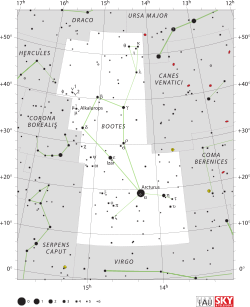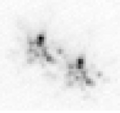Zeta Boötis
| Observation data Epoch J2000 Equinox J2000 | ||
|---|---|---|
| Constellation | Boötes
| |
| Right ascension | 14h 41m 08.95158s[1] | |
| Declination | +13° 43′ 41.8967″[1] | |
| Apparent magnitude (V) | 3.78[2](4.46 + 4.55)[3] | |
| Characteristics | ||
| Spectral type | A2III + A2III[4] A1V[5] | |
| U−B color index | +0.05[2] | |
| B−V color index | +0.05[2] | |
| Absolute magnitude (MV) | +0.13[7] | |
Argument of periastron (ω)(secondary) | 262.9±5.9° | |
| Details | ||
| Luminosity | 81[7] L☉ | |
HR 5477[11] | ||
| Database references | ||
| SIMBAD | data | |
Zeta Boötis,
light years from the Sun based on parallax,[1] but is drifting closer with a radial velocity of −9 km/s.[6]
The duplicity of this star was discovered by English astronomer
AU at their closest approach. The next close approach will occur during August 2023.[8]
In 1976, T. W. Edwards found a
giant stars. Helmut A. Abt reported a class of A2V in 1981, which matches an A-type main-sequence star.[13] Abt and Nidia Morrell updated the classification to A1V in 1995.[5] Considering the extreme nature of their orbit, it is unlikely that any companion exoplanets could have stable orbits around either star.[14]
Gallery
-
Zeta Bootis imaged with theAiry discs around the stars is diffractionfrom the 2.56m telescope aperture.)
-
Typical short-exposure image of a binary star, as seen using speckle imaging through the Earth's atmosphere.
References
- ^ S2CID 18759600
- ^ Bibcode:1978A&AS...34....1N.
- ^ doi:10.1086/323920.
- doi:10.1086/111879.
- ^ doi:10.1086/192182.
- ^ S2CID 119231169.
- ^ S2CID 119257644.
- ^ S2CID 6030289.
- ^ "zet Boo". SIMBAD. Centre de données astronomiques de Strasbourg. Retrieved 2020-12-31.
- ^ "zet Boo A". SIMBAD. Centre de données astronomiques de Strasbourg. Retrieved 2020-12-31.
- ^ "zet Boo B". SIMBAD. Centre de données astronomiques de Strasbourg. Retrieved 2020-12-31.
- Bibcode:1956AcA.....6...82W.
- doi:10.1086/190719.
- S2CID 9272936.
External links
- Kaler, James B., "ZETA BOO (Zeta Bootis)", Stars, University of Illinois, retrieved 2011-12-18
- HR 5477
- Image Zeta Boötis
- CCDM J14411+1344



